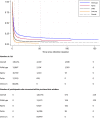Long-term health impacts of COVID-19 among 242,712 adults in England
- PMID: 37875536
- PMCID: PMC10598213
- DOI: 10.1038/s41467-023-41879-2
Long-term health impacts of COVID-19 among 242,712 adults in England
Abstract
The COVID-19 pandemic is having a lasting impact on health and well-being. We compare current self-reported health, quality of life and symptom profiles for people with ongoing symptoms following COVID-19 to those who have never tested positive for SARS-CoV-2 infection and those who have recovered from COVID-19. Overall, 276,840/800,000 (34·6%) of invited participants took part. Mental health and health-related quality of life were worse among participants with ongoing persistent symptoms post-COVID compared with those who had never had COVID-19 or had recovered. In this study, median duration of COVID-related symptoms (N = 130,251) was 1·3 weeks (inter-quartile range 6 days to 2 weeks), with 7·5% and 5·2% reporting ongoing symptoms ≥12 weeks and ≥52 weeks respectively. Female sex, ≥1 comorbidity and being infected when Wild-type variant was dominant were associated with higher probability of symptoms lasting ≥12 weeks and longer recovery time in those with persistent symptoms. Although COVID-19 is usually of short duration, some adults experience persistent and burdensome illness.
© 2023. Springer Nature Limited.
Conflict of interest statement
The authors declare no competing interests.
Figures



References
-
- John_Hopkins_Coronavirus_Resource_Center. COVID-19 Dashboard 2023. Available at: https://coronavirus.jhu.edu/map.html. Accessed 18 June 2023.
Publication types
MeSH terms
Grants and funding
LinkOut - more resources
Full Text Sources
Medical
Miscellaneous

